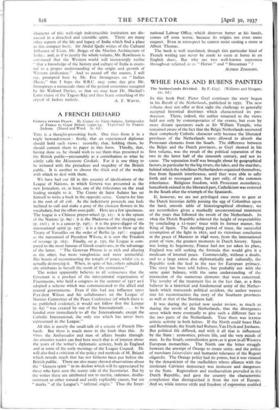WHILE HALS AND RUBENS PAINTED
IN this book Prof. Pieter Geyl continues the story begun in his Revolt of the Netherlands, published in 1932. The new volume does not offer at first sight the challenge to generally accepted historical doctrines which characterised its pre- decessor. There, indeed, the author returned to the views held not only by contemporaries of the events, but even by more distant spectators such as Sir William Temple, who remained aware of the fact that the Belgic Netherlands recovered their completely Catholic character only because the liberated provinces of the Netherlands were• allowed to absorb the Protestant elements from the South. The difference between the Belgic and the Dutch provinces, as Geyl showed in his first volume, was the result of the political separation of the two in the latter half of the sixteenth century, and not its cause. The separation itself was brought about by geographical factors, in particular by the big rivers, the lakes, and the marshes, behind which the rebellious Netherlanders organised themselves, free from Spanish interference, until they were able to sally forth and to reconquer part, but part only, of the common inheritance. Religious freedom, with Protestant ascendancy, henceforth existed in the liberated part, Catholicism was restored in the South after the triumph of the Spaniards.
If, however, we are not privileged once more to gaze at the Dutch historian deftly poising the egg of Columbus upon the hard, smooth table of historiographical obstinacy, we are nevertheless given a markedly unconventional treatment of the years that followed the revolt of the Netherlands. In 1609 the Dutch Republic achieved the height of respectability by concluding a 12-years' truce with its former master, the King of Spain. The dazzling period of truce, the successful resumption of the fight in 1621, and its victorious conclusion at the peace of Munster in 1648 were, from the international point of view, the greatest moments in Dutch history. Spain was losing its hegemony, France had not yet taken its place, England was still seeking the formula that would give it a modicum of internal peace. Commercially, without a doubt, and to a large extent also diplomatically and culturally, the Republic took the lead in the race for European primacy. The story has been told before, but probably not with the same quiet balance, with the same understanding of the interaction of the numerous elements that were concerned. The novelty of the treatment lies in the fact that, as a firm believer in a historical and fundamental unity of the Nether- lands which transcends political accident, the author weaves into his reconstruction the story of the Southern provinces as well as that of the Northern half.
It was during the period now under review, as much as during the revolt of the Netherlands, that the divergences arose which were eventually to give such a different face to the two parts of the Netherlands. True there was intense artistic activity in both halves. If the North could boast Hals and Rembrandt, the South had Rubens, Van Dyck and Jordaens. But political life differed, and with it all that is influenced by the State : economics, private life, and the very minds of men. In the South, centralisation grew; as it grew in all Western European monarchies. The North saw the bitter struggle between the attempt of Orange to create unity, and the policy of merchant laissez-faire and humanist tolerance of the Regent oligarchs. The Orange policy had its points, but it was vitiated by the dynasticism of the stadholders whose alliance with the intolerant Calvinist democracy was insincere and dangerous to the State. Regionalism and mediaevalism prevailed in the Dutch Republic, and gave the country the characteristic complexion that distinguished it from the rest of Europe. 'Anti so, while intense strife and freedom of expression enabled.
the literature of the North to unfold itself with unprecedented splendour, the South kept its writers in the strait-jacket of the Counter-Reformation and had to be content with the popular literature of moralists and rhetoricians.
Yet through all this divergence ran the thread of a common language. Flanders and Brabant spoke Dutch like the ' liberated provinces. For Prof. Geyl, in whose opinion language is the very essence of nationhood, this fact dominated the period of 1609 to 1648, as much as the previous or indeed the succeeding periods. He notes with joy the many expressions of a common national consciousness which appear in the North as well as in the South. His story of the early years of Netherlands division may be wistful, upon occasion, but it is vitalised by the author's epic vision, and by his faith in the significance of his subject, a faith which his vivid narrative will not fail to communicate



































































 Previous page
Previous page